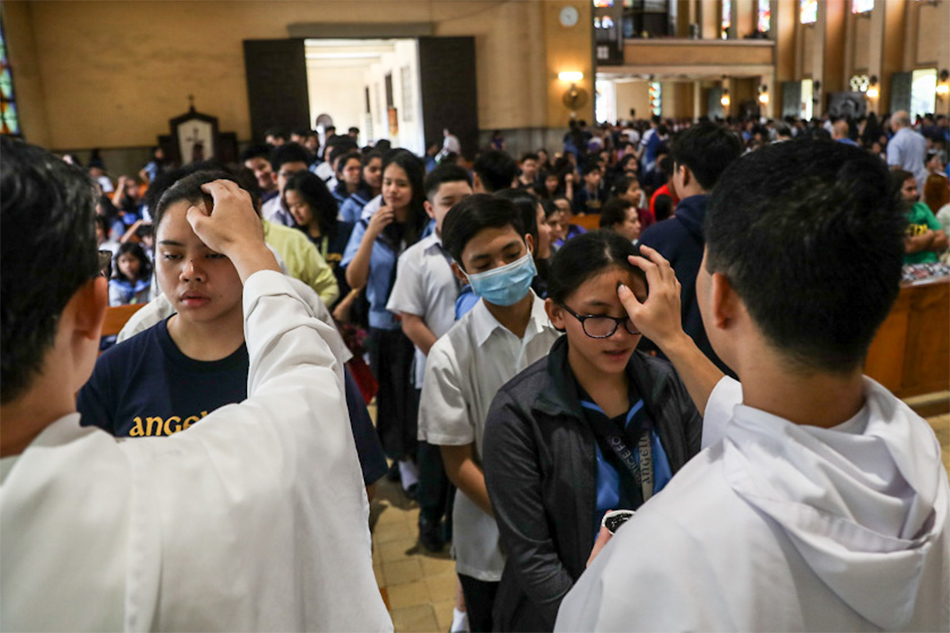CBCP's exec suggests sprinkling of dry ashes instead of marking foreheads amid COVID-19 outbreak | ABS-CBN

Welcome, Kapamilya! We use cookies to improve your browsing experience. Continuing to use this site means you agree to our use of cookies. Tell me more!
CBCP's exec suggests sprinkling of dry ashes instead of marking foreheads amid COVID-19 outbreak
CBCP's exec suggests sprinkling of dry ashes instead of marking foreheads amid COVID-19 outbreak
ABS-CBN News
Published Feb 18, 2020 07:57 PM PHT
MANILA - A week before Ash Wednesday, the vice president of the Catholic Bishops' Conference of the Philippines (CBCP) suggested the sprinkling of dry ashes on the head instead of using wet ashes on the forehead amid the novel coronavirus (COVID-19) outbreak.
MANILA - A week before Ash Wednesday, the vice president of the Catholic Bishops' Conference of the Philippines (CBCP) suggested the sprinkling of dry ashes on the head instead of using wet ashes on the forehead amid the novel coronavirus (COVID-19) outbreak.
Caloocan Bishop Pablo Virgilio David on Tuesday released several guidelines to be observed in the Church's liturgies as a response to the concerns about the spread of the virus.
Caloocan Bishop Pablo Virgilio David on Tuesday released several guidelines to be observed in the Church's liturgies as a response to the concerns about the spread of the virus.
"In place of imposing wet ashes on the foreheads of the faithful, we can sprinkle a pinch of dry ashes on the crown or the top of their heads," the prelate said.
"In place of imposing wet ashes on the foreheads of the faithful, we can sprinkle a pinch of dry ashes on the crown or the top of their heads," the prelate said.
The imposition of ashes with the sign of the cross on the forehead has been a tradition among Filipino Catholics during Ash Wednesday. But in other parts of the world like in Rome, the sprinkling of dry ashes on the head is the more common practice.
The imposition of ashes with the sign of the cross on the forehead has been a tradition among Filipino Catholics during Ash Wednesday. But in other parts of the world like in Rome, the sprinkling of dry ashes on the head is the more common practice.
ADVERTISEMENT
This year, Ash Wednesday falls on February 26, signalling the beginning of the season of Lent in the Catholic Church. The 40-day season is marked by intense prayer, fasting, and abstinence as preparations for the great feast of Easter.
This year, Ash Wednesday falls on February 26, signalling the beginning of the season of Lent in the Catholic Church. The 40-day season is marked by intense prayer, fasting, and abstinence as preparations for the great feast of Easter.
Meanwhile, David also suggested the following measures:
Meanwhile, David also suggested the following measures:
- In place of holy water by the entrance doors, holy water can just be sprinkled on the faithful by the priests and lay ministers during the recessional;
- In place of holy water by the entrance doors, holy water can just be sprinkled on the faithful by the priests and lay ministers during the recessional;
- In place of shaking hands for the sign of peace, a reverent bow towards each other will be enough;
- In place of shaking hands for the sign of peace, a reverent bow towards each other will be enough;
- Instead of taking the hand of the priests or of elders for a blessing, individuals can ask for the blessing verbally (as in “Pa-bless po!”) and receive it verbally as well, such as “God bless you!”
- Instead of taking the hand of the priests or of elders for a blessing, individuals can ask for the blessing verbally (as in “Pa-bless po!”) and receive it verbally as well, such as “God bless you!”
ADVERTISEMENT
The bishop also encouraged the faithful to do other acts of penance like fasting and giving alms.
The bishop also encouraged the faithful to do other acts of penance like fasting and giving alms.
He said a formal circular will be released this week regarding these guidelines.
He said a formal circular will be released this week regarding these guidelines.
There were only three confirmed cases of COVID-19 in the Philippines, all were Chinese nationals who traveled from Wuhan, the epicenter of the disease.
There were only three confirmed cases of COVID-19 in the Philippines, all were Chinese nationals who traveled from Wuhan, the epicenter of the disease.
The first two were a couple — a 38-year-old woman and a 44-year-old man. While the man died due to the respiratory illness, the woman recovered and was evantually discharged.
The first two were a couple — a 38-year-old woman and a 44-year-old man. While the man died due to the respiratory illness, the woman recovered and was evantually discharged.
The third case of COVID-19 was a 60-year-old Chinese woman who recovered and was discharged before it became known she was earlier infected by the virus.
The third case of COVID-19 was a 60-year-old Chinese woman who recovered and was discharged before it became known she was earlier infected by the virus.
ADVERTISEMENT
Meanwhile, the Catholic Church in Hong Kong has decided to suspend all public Masses and the liturgy of Ash Wednesday for two weeks due to the threat of the COVID-19 outbreak.
Meanwhile, the Catholic Church in Hong Kong has decided to suspend all public Masses and the liturgy of Ash Wednesday for two weeks due to the threat of the COVID-19 outbreak.
ADVERTISEMENT
ADVERTISEMENT


